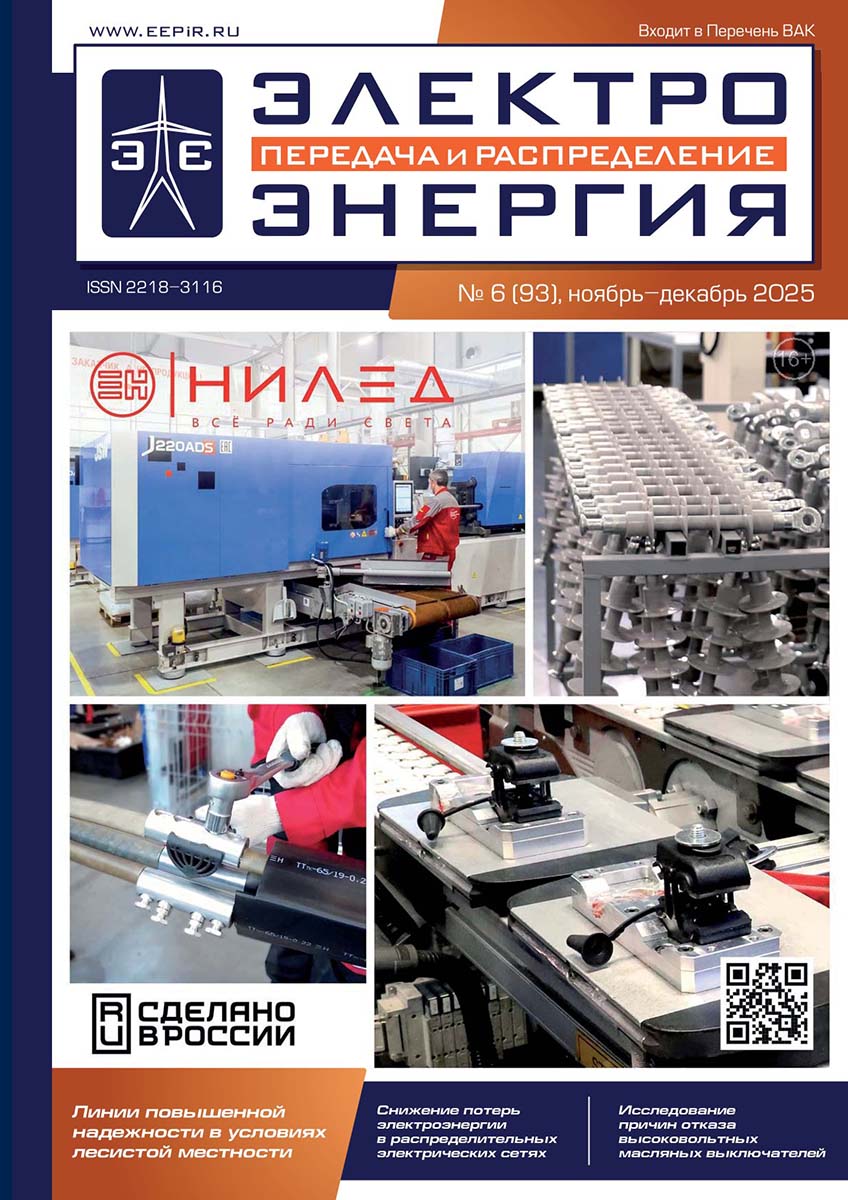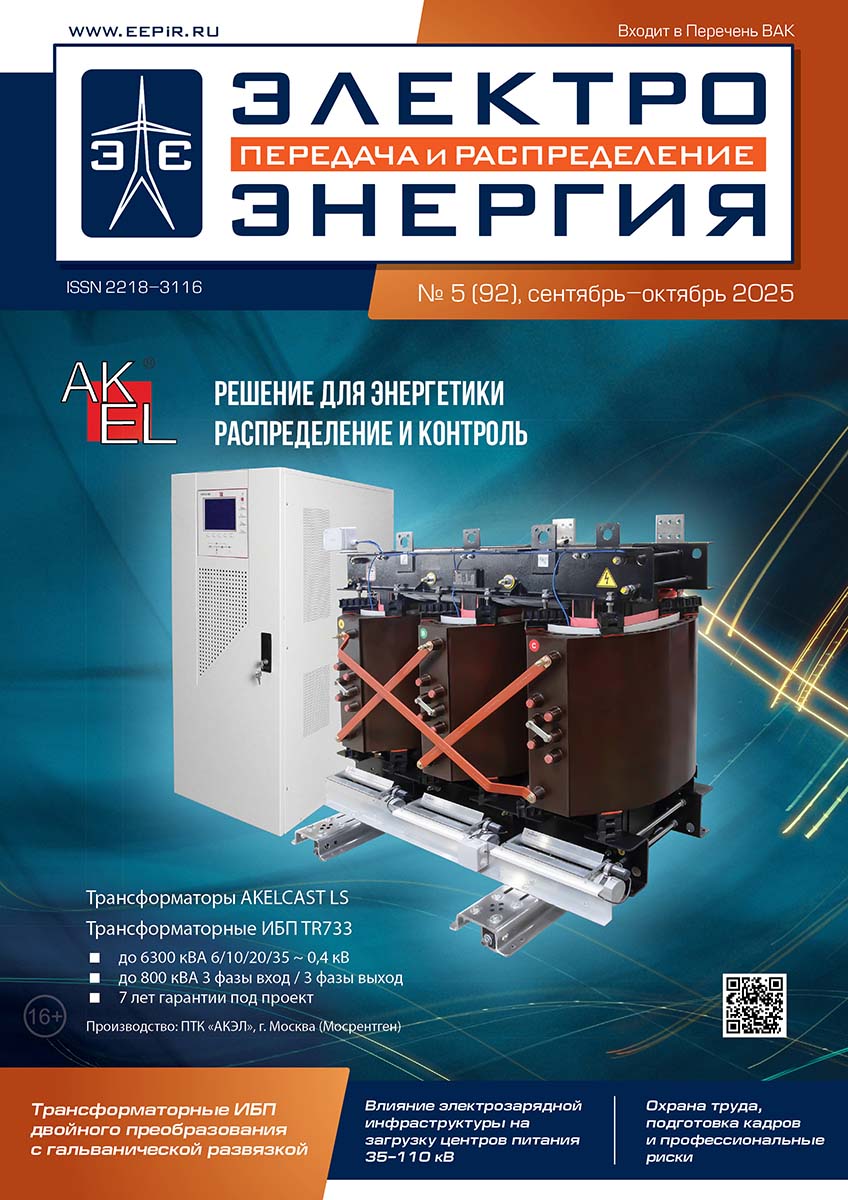
21 ноября 2024
АНОНС «ЭЛЕКТРОЭНЕРГИЯ. Передача и распределение» № 6(87), ноябрь-декабрь 2024
28 статей в открытом доступе
Оформить подпискуОформите подписку, чтобы получить доступ ко всем материалам выпуска, или купите нужную статью отдельно
Уже есть подписка? Тогда авторизуйтесь.
ЦИФРОВАЯ ТРАНСФОРМАЦИЯ
ЭНЕРГОСНАБЖЕНИЕ
УДК 621.315.1:621.3.064.1:004.94
ЭНЕРГОСНАБЖЕНИЕ
ЭНЕРГОСНАБЖЕНИЕ
ЭНЕРГОСНАБЖЕНИЕ
КАЧЕСТВО ЭЛЕКТРОЭНЕРГИИ
ВОЗДУШНЫЕ ЛИНИИ
ВОЗДУШНЫЕ ЛИНИИ
ВОЗДУШНЫЕ ЛИНИИ
КАБЕЛЬНЫЕ ЛИНИИ
КАБЕЛЬНЫЕ ЛИНИИ
ДИАГНОСТИКА И МОНИТОРИНГ
УДК 621.316.1
ДИАГНОСТИКА И МОНИТОРИНГ
ДИАГНОСТИКА И МОНИТОРИНГ
ОБОРУДОВАНИЕ
ОБОРУДОВАНИЕ
ОБОРУДОВАНИЕ
УДК 621.365.22:621.315.68
РЕЛЕЙНАЯ ЗАЩИТА И АВТОМАТИКА
РЕЛЕЙНАЯ ЗАЩИТА И АВТОМАТИКА
УДК 621.316.925
ОХРАНА ТРУДА
ПРОИЗВОДСТВЕННЫЙ ТРАВМАТИЗМ
TOPICAL INTERVIEW
First-Priority Tasks of Power Grids Development
Interview with the Deputy Minister of Energy of the Russian Federation Е.P. Grabchak
DIGITAL TRANSFORMATION
Boosted Migration from Windows Based SCADA to SCADA Linux with CIM
OOO PLC Systems
Automation as a Key Factor of Security
OOO IT Bastion
ASMOgraph — the Local Substitute of MS Visio with Adaptation to Power Utilities
AO Informatika
Complex Cyber Security is the Only Response to Threats
К2 Cybersecurity
POWER SUPPLY
Computer Simulation of the Sustained Single-Phase Fault Mode in a Rural Network 0.4 kV with Consideration of the Load Impact
Lansberg A.A., Vinogradov A.V. (FSAC VIM, Moscow)
Abstract. Simulation of faults in electric networks is a top issue of today as it helps to define the typical parameters of networks required for adjustment of automation equipment. A lot of research is dedicated to single-phase faults in0,4 kV networks. However, in the majority of studies the load impact on the fault current is not considered at all. We used MATLAB Simulink SW complex to study the steady single-phase fault mode with the load connected to the faulty phase. A 0.4 kV network was chosen as the prototype. It is supplied by the transformer ТМ-250/10/0,4 кВ Y/Yн with the 1 km-long wire А-35. The loads with permanent resistances 0,5 Ohm, 1 Ohm, 5 Ohm, 10 Ohm were connected to the faulty phase every 100 m of the transmission line depending on the distance from the transformer and to the fault point. The study showed that connection of loads with 1 Ohm and 0,5 Ohm resistances, which differ from that of the line in 1,2 and 1,7 times, 400–700 m away from the 0,4 kV transformer lead provides for the fault current decrease behind the load connection point in 1,3–1,5 times. At the same time, use of 5 Ohm and 10 Ohm loads does not considerably impact the fault current behind the load connection point. The maximum single phase fault current decrease behind the load connection point is typical in case of connecting the load to a faulty phase 500–600 m away from the 0,4 kV power transformer lead.
Keywords: electric network, single-phase fault, load, simulation, MATLAB Simulink, transformer
Reliability and Quality of Power Supply for the Oil Industry
Review of the Meeting of chief power engineers of petrochemical plants and oil refineries of Russia and CIS countries
Implementation of Automatic Network Recovery System in a 10 kV Distribution Network of Kultaevo RES — Permenergo Branch of PJSC Rosseti Ural
Creation of Automatic Self-Recovery System for 6 kV Cable Networks Based on Local Automation of Advanced Reclosers for Transformer Substations JSC Grid Company — Naberezhnye Chelny electric networks
Technical Solutions for Energy Storage Batteries STARK ESS Based on Lithium-ion Storage Batteries STARK LITHIUM
ZAO AKKU-FERTRIB
POWER QUALITY
About the Necessity of Control and Standarding of Current Harmonics
Beley V.F., Korotkikh K.V. (Kaliningrad State Technical University)
Abstract. The paper considers the physical aspects of the occurrence of current harmonics in electrical networks and shows their relationship with voltage non-sinusoidality. The results of experimental studies of powerful nonlinear electrical receivers (suburban railway and electric arc furnace) showed a high level of higher harmonics of current generated by them in the power supply network. At the same time, the level of voltage harmonics at the point of common connection did not exceed the standard value. It has been shown that ignoring control over the level of higher current harmonics and the lack of regulatory requirements for them in the GOST 32144-2013 standard leads to serious consequences. The most effective measures to reduce the levels of higher current harmonics generated by nonlinear electrical receivers into the supply network are presented.
Keywords: the latest electrical technologies, distorting loads, current, voltage, harmonics, standards
OVERHEAD TRANSMISSION LINES
Flexible Carbon Fiber Grounding is an Effective Solution for challenging Operating Conditions of Overhead Transmission Lines
OOO PARMA
PO FORENERGO Looks Back on the Year
Contribution of Tulskiy Elektromehanicheskiy Zavod, OOO into Development of the Russian Power Grid
YUAIZ: Quality is the Priority
Steady-State and Feasibility Analysis of Composite Core Conductors for 110 kV Power Grid Prospective Planning
Zamarin D.O., Zaikov I.A.(PJSC «Rosseti Ural») Samoylenko V.O. (UrFU n.a. B.N. Yeltsin, Yekaterinburg)
Abstract. The paper presents a comparative analysis of a 110 kV distribution grid capacity for the cases of overhead power lines equipped with conventional aluminium conductor steel-reinforced wire and with high-temperature low-sag wire. Based on the results of calculation experiments, the maximum values of transmission capacity in winter and summer states are estimated for both a single overhead line and a meshed distribution grid. The advantages of low-sag wire in terms of steady-state calculations are considered. A cost analysis is provided for the support of overhead line wire replacement with a composite one in comparison with the reconstruction of an overhead line, the construction of a second power line and switching it to the higher voltage class. The results of the paper are in demand by energy and engineering companies involved in future planning of distribution grids.
Keywords: low-sag overhead power line conductor, high-temperature power line conductor, distribution grid, transmission capacity, future planning
CABLE LINES
Design and Production of NILED Cable Sleeves
Thermal-Resistant Pipes for Cable Protection — not Obvious, However Works
Operation Costs Reduction and Reliability Improvement of Cable Lines by Using Current-Searching Tubes with the Fault Location Detection Ability
Study of Dielectric Strength of HV Cable Sleeves at Exposure to Low Temperatures
OOO ARKASIL SK
0,4–35 kV Cable Accessories. Trustworthy Contact
OOO Raytek
DIAGNOSTICS AND MONITORING
Model Travelling Wave Fault Location in Tree-Like Distribution Networks
Khuzashev R.G., Tukhfatullin I.R. (KSPEU, Kazan) Tukaev S.M. (GC «Escort»)
Abstract. The paper studies model algorithms for multilateral travelling wave fault location in electrical branched networks. The model algorithm is based on finding the minimum of the objective function when varying the fault location, travelling wave’s speed, and line’s length. Travelling wave fault location complex calculates the time delay of traveling wave’s arrival at each end of the line relative to the base end. Target function consists of module or modules’ sum of calculated time delays’ difference. Paper shows that target function’s minimum, taking into account only two ends of the line, matches the set of combinations of fault location and traveling wave propagation speed. Taking into account three ends of the line removes the uncertainty associated with the travelling wave propagation speed. Taking into account all ends of the line reduces the influence of network’s length determination error.
Keywords: travelling wave, transient signal, experiment, time delays, target function, error
Experience of Using the Fault Indicators and the Remote Monitoring Modules in 35 kV and Higher Overhead Lines in PJSC Rosseti Moscow Region
Neural Network Application for Smart Analysis of Overhead Transmission Line’s Condition with the Use of UAVs
PJSC Rosseti Center, Unmanned Systems Group, OOO VizorLabs
A Key Function in the New UV-control Camera
AO KT-Bespilotnye Sistemy
EQUIPMENT
Experience of Commissioning and Operation of Shunt Reactor Synchronous Switches
OOO ASU-VEI, ООО ABM-Energo
Reliable Supplier of Carrier Equipment
CJSC «Research and Production Enterprise «Electronic Information Systems» (EIS)
H Energy — A Startup Company with the Years-Long history
Reliability of Electric Networks — SystemElectric Presents the Advanced Solution for Urban Environment
System NKU FORMAT PRO by IEK
CHINT Solutions for Sustainable Development of the Russian Power Industry
Switchgears EVOLUTION by ID-Engineering — Technologic Independence in Focus
ZETO — 65 Year Anniversary. History of Innovations
Composite Materials Fomalgaud®: Availability at the Emergency Stock as a Guarantee of Effectiveness and High-Quality Repair
Analysis of Damage to the End Couplings of 35 kV Cables and Assessment of Damage in the Arc Steel Furnace System
Tugulbaev S.A., Kornilov G.P. (MGTU n.a. G.I. Nosov, Magnitogorsk)
Abstract. The article considers the effect of a static thyristor compensator on the performance of an arc furnace. The relationship between the power and the voltage of the furnace is presented, the stabilization of which is provided by a static compensator. To assess the damage, the statistics of failures of electrical equipment that ensures the continuity of operation of the furnace and the static compensator are given. The analysis of the operating voltage at the point of common connection to the electrical equipment of the main step-down substation of the furnace was carried out. Special attention is paid to the end couplings of supply cables with a rated voltage of 35–42 kV. The paper calculates the damage caused by a decrease in the performance of the arc furnace due to a power outage of the static compensator as a result of the prevailing failures of cable lines. When calculating the damage, the average time required for restoration in real production conditions is taken into account.
Keywords: damage, cables, arc furnaces, static thyristor compensator, electrical equipment failures, reliability, metallurgy
RELAY PROTECTION AND AUTOMATION
The Present and the Future of Digital and Intelligent Relay Protection and Automation Systems
Review of the conference «Digital and Intelligent relay protection and automation systems»
Development of a Relay Protection Algorithm Against Turn Faults in the Stator Winding of a Synchronous Generator
Glazyrin G.V., Kirichenko V.F.,Fyodorova V.A. (Novosibirsk State Technical University)
Abstract. Increasing the sensitivity to winding faults of synchronous generators by developing innovative methods of fault detection is an important task in the field of relay protection realization. This paper presents a description of the working principle of the algorithm of a new type of relay protection against winding faults in the stator winding of a synchronous generator by a direct method based on the unbalance voltage in the stator phase circuits. By analyzing the fundamental principles of relay protection, design and operational features of synchronous machines, the paper reflects the potential of the proposed relay protection algorithm to improve the stability, safety and performance of electric power facilities.
Keywords: relay protection, winding faults, synchronous machine, fault detection, electrical equipment, generator reliability
LABOR PROTECTION
Basic Approaches to Formation of Local Regulatory Acts on Provision of Individual Protection Means
NRU MPEI, NAOT Association
INDUSTRIAL INJURIES
Dynamics of the Work-Related Injuries in Quarter III of 2024
Russian Federal Service for Ecological, Technical and Atomic Supervision; Association “ERA of Russia”
JOURNEY THROUGH THE PAST
Generation Succession as a Key Factor of Sustainable Development of the Power Industry
Tavrida Electric Company, NRU MPEI









